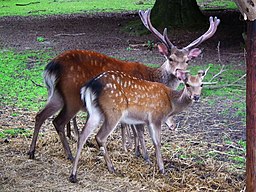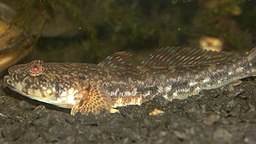 |
Fallow deer | Status LU: established. 1st record: 1977. |
 |
Damhirsch | Status Eur.: established. |
 |
Daim européen | RA: ISEIA: B2, Watch List. Harmonia+: n/a. |
 |
Damhirsch | Wikipedia:     | Wikispecies: | Wikispecies:  |
 |
Damhert | Back to the list of vertebrates |
Contents
Brief description
Dama dama (Linnaeus, 1758) prefers open, deciduous woodlands and conifer plantations with open areas. Fallow deers are very adaptable to almost all ecological conditions. The species can cause considerable damage to woodlands when populations are not managed. At high densities, they can alter the structure of vegetation communities and cause biodiversity loss, although moderate deer densities tend to promote higher biodiversity. Above some density threshold, fallow deer can also cause the decline of roe deer populations (Branquart et al. 2009).The species originates from the Near East (Turkey, Iran, etc.) (Schley & Herr 2019:32).
Status and distribution in Luxembourg
Records of Dama dama Linnaeus, 1758 in Luxembourg. Data source: Recorder-Lux, iNaturalist & GBIF, 2025-12-18.
In Luxembourg, Dama dama (Linnaeus, 1758) is thought to have been introduced accidentally into the wild when some individuals escaped from the animal park in Hosingen in 1977.
Hunting statistics show that the population of fallow deer is concentrated in the southern part of the Upper Sauer region and in the Our valley (Naturverwaltung 2012, Naturverwaltung 2014, Schley & Herr 2019: 32; Schley & Celllina 2018: 27).
Records in the Recorder-Lux database show that fallow deers also live in the Mullerthal region (MNHNL 2000-).
Fallow deer hunt in Luxembourg
The first fallow deer were shot in 1979 and numbers shot reached 54 in 1995 (Schley et al. 1998). In the 1990s, the number of shot deer per year amounted to over 50 and increased to approximately 125-150 animals since 2007.
The geographical distribution of shot fallow deers for the hunting year 2017/18 (see map on the right) is in line with the fallow deer distribution (see above) based on data from Recorder-Lux, GBIF and iNaturalist (MNHNL, iNaturalist & GBIF 2020).
Risk assessment
ISEIA protocol
B2 (3+3+2+1) = Watch List (Ries et al. 2014: 199).
Harmonia+ protocol
Not assessed yet.
Worldwide distribution

CABI 2019: https://www.gbif.org/species/5220136
Bibliography
- Branquart, E., M. D’aes, A. Licoppe, B. Manet, G. Motte, V. Schockert & J. Stuyck, 2009. Harmonia database: Dama dama (Linnaeus, 1758). Harmonia version 1.2, Belgian Forum on Invasive Species. URL: http://ias.biodiversity.be [accessed on 2019-10-28]
-
GBIF, 2019. Dama dama (Linnaeus, 1758) in GBIF Secretariat (2019). GBIF Backbone Taxonomy. Checklist dataset https://doi.org/10.15468/39omei [accessed 2020-04-22]
- Klees, H., 1981. Luxemburger Tiernamen. Beiträge zur luxemburgischen Sprach- und Volkskunde XIV. Institut grand-ducal, Section de linguistique, de folklore et de toponymie. 2. Aufl. 131 S. Imprimerie Pierre Linden, Luxembourg.
- MNHNL, 2000-. Dama dama (Linnaeus, 1758) in Recorder-Lux, database on the natural heritage of the Grand Duchy of Luxembourg. Musée national d’histoire naturelle, Luxembourg. URL: https://mdata.mnhn.lu [Accessed 2020-02-04]
- MNHNL, iNaturalist & GBIF, 2019. Dama dama (Linnaeus, 1758) in MNHNL-mdata, online portal combining species observation from Recorder-Lux, iNaturalist and GBIF. National Museum of Natural History, Luxembourg. URL: https://mdata.mnhn.lu [Accessed 2020-02-04]
- Naturverwaltung (ed.), 2012. Technischer Bericht der Naturverwaltung betreffend Wildtiermanagement und Jagd, Nummer 2 (2012), 68 pp.
- Naturverwaltung (ed.), 2013. Jagbare Wildtierarten Luxemburgs. 96 pp.
- Naturverwaltung, 2014. Bulletin technique de l’Administration de la nature et des forêts en matière de gestion de la faune sauvage et de chasse, numéro 3 (2014), 72 pp.
- Pir, J.B. & L. Schley, 2015. Développement des connaissances sur la répartition et l’écologie des mammifères au Luxembourg entre 1990 et 2015. Bull. Soc. Nat. luxemb. 116: 437-455.
- Ries, C., M. Pfeiffenschneider, Engel, E., J.-C. Heidt & M. Lauff, 2014. Environmental impact assessment and black, watch and alert list classification after the ISEIA Protocol of vertebrates in Luxembourg. Bull. Soc. Nat. luxemb. 115: 195-201. [PDF 247 KB]
- Schley, L. & J. Herr, 2019. Säugetiere Luxemburgs. Hrsg.: natur&ëmwelt a.s.b.l., Ministère du développement durable et des infrastructures, Administration de la nature et des forêts. 219 S. ISBN 978-2-9199511-0-9 [French edition: Les mammifères du Luxembourg, ISBN 978-2-9199511-2-3]
- Schley, L. & S. Cellina, 2018. Technischer Bericht der Naturverwaltung betreffend Wildtiermanagement und Jagd, Nr. 7, 52 S. Administration de la nature et des forêts, Diekirch. [PDF 13 MB]
- Schley, L., A. Krier, A. Baghli & T.J. Roper, 1998. Hunting records of game species in Luxembourg during the period 1946 to 1995.. Bull. Soc. Nat. luxemb. 99: 69-75. [PDF 47KB]
Page content last updated on 2020-04-22. Last proofread by Caroline Grounds on 2019-11-27.
















